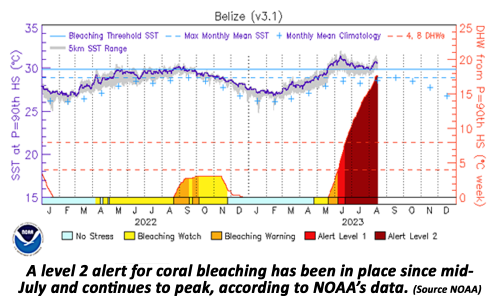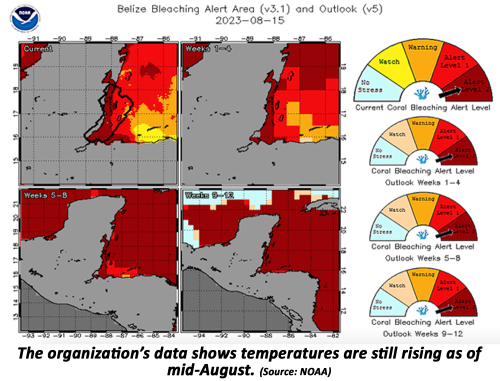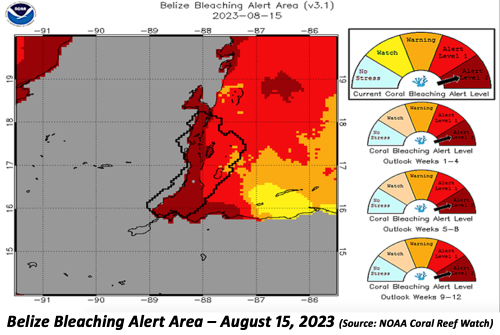Photo: Bleached fire coral at a restored site at Laughing Bird Caye National Park, Belize.
by Marco Lopez
BELIZE CITY, Thurs. Aug. 17, 2023
On Monday, the World Meteorological Organization officially confirmed that Earth just had its hottest month on record. July 2023 will be remembered for the unprecedented heat stress experienced globally.
While these conditions caused heat waves and new temperature spikes in nations around the world, vital ecosystems in the oceans were also impacted by marine heat waves. Widespread coral bleaching has occurred across the Americas and the Caribbean as a result of the unprecedented heat stress.
In Belize, the non-profit organization focused on coral restoration, Fragments of Hope has identified heat-stressed and bleached pockets of coral reef in the Laughing Bird Caye National Park coral cover.
According to data from the US National Oceanic and Atmospheric Administration (NOAA) Coral Reef Watch, a level 2 coral bleaching alert is in place currently for Belize. This is the highest warming level. Satellite imagery shows a probable bleaching area covering the entire coast of the country.
This is a grim reality for the Mesoamerican Barrier Reef, the heart of which lies within the Belize coastal zone. The second largest barrier reef in the world and the largest within the Atlantic Ocean stretches across four countries: Belize, Guatemala, Honduras, and Mexico.

What is Coral Bleaching?
Coordinator at NOAA’s Coral Reef Watch, Derek Manzello explains that if ocean temperatures are higher than the max monthly average for a month or more, the coral will experience bleaching. Bleached corals are essentially starving to death due to the loss of their main source of nutrition – the algae that live in symbiosis within its tissues.
Damage to coral depends on how long the heat stress occurs and its magnitude. Corals can recover from bleaching if the heat stress subsides. The corals that have experienced a bleaching event, however, are often affected by impaired growth and reproduction and are susceptible to disease for a period after recovery.
If heat stress is prolonged, corals will die.
If sea temperatures are 1°C greater than the historical monthly average for a duration of two months, it will lead to fatalities. If temperatures are 2°C greater than the monthly average, fatality could occur in one month. With a temperature deviation of 3°C, the coral will start experiencing mortality in less than three weeks.

Sadly, It Could Get Worse
Data from NOAA Coral Reef Watch shows the current near-real-time coral bleaching thermal stress and projected alert level for three consecutive four-week periods. The organization cites a 60% probability that a bleaching alert level 2 will be in place in Belize over the next 12 weeks.
A 2022 paper based on data gathered using satellite imagery from 2002 to 2022, found that Corozal Bay, Swallow Caye, Port Honduras, and South Water Caye Marine Reserve had the highest percentage of stress days and coral vulnerability stress according to parameters used in the study.

Climate Change and Global Heating and Coral Bleaching
It is well established that the widespread use of fossil fuels and the greenhouse gases emitted by human activity are the primary cause of the extreme heat affecting both land and marine ecosystems.
Global heating causes large areas of reefs across the world to become susceptible to warming-induced coral bleaching.
Given that climate change models suggest an increase in sea surface temperature of 1 – 3 °C over the next 50-100 years, coral bleaching events may become an intense and annual stress on reefs throughout the Caribbean and the world.
Climate-induced coral bleaching also results in wholesale ecosystem changes for coral communities. These ecosystems are considered engineers that literally shape the habitat in which other marine species interact. When corals are removed, the homes of thousands of juvenile marine species are also lost. When coral dies following a bleaching event, it is replaced by algae or other non-corals.
This in turn affects the local marine food supply, and the range of ecosystem services such as coastal protection from erosion and storm surges, and tourism revenue derived from healthy reefs.
Belize and the MAR
The 185-mile-long barrier reef system off the coast of Belize experienced a downward spiral in health leading to UNESCO placing Belize’s Barrier Reef Reserve System on its List of World Heritage Sites in Danger. Within 10 years – by 2019 – Belize was the highlight of the organization’s report; the reef was removed from the list of endangered sites. The country put measures in place to mitigate the threats to the reef, instituted a moratorium on oil exploration, banned unsustainable fishing practices, and revised regulations for mangrove protection.
Belize’s Strategy for Reef Resilience, published this year, notes, “While these efforts have been sufficient to be removed from the List of World Heritage Sites in Danger in 2018, many threats persist. The largest reaching of these is climate change. Anthropogenic (human-caused) increases in seawater temperatures are causing coral bleaching, resulting in high mortality, while the uptake of carbon dioxide is reducing the ocean’s pH which slows coral growth and dissolves the reef matrix.”
The Belize Coral Watch was created under the Mesoamerican Coral Reef Watch Program in 2008 to develop a coral watch program in Belize. That program is volunteer-based. We reached out to that organization but received no reply. Belize’s last Coral Bleaching Response and Management Plan ran from 2008 to 2013. No update to such a document has been published yet.
We reached out to the Ministry of the Blue Economy for an update on the Coral Bleaching management plan and for a comment on the recent data but received no reply.
The Resilient Reef Strategy published this year cites its number 1 plan of action as strengthening coral reef resilience. It points out that stony coral tissue loss disease and bleaching events are the two most pressing threats.
Despite this, “reef managers have limited capacity and time to analyze the health and resilience of systems,” the report states.

